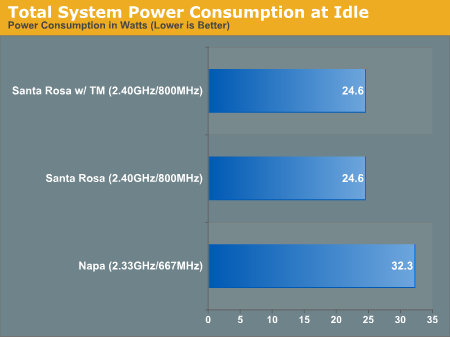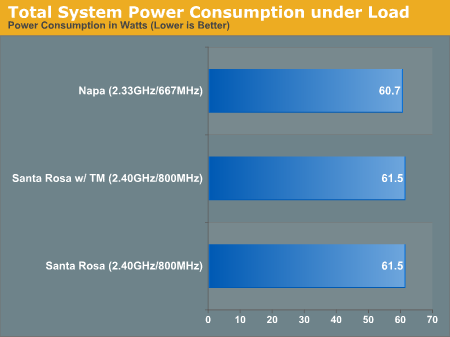Intel Santa Rosa Preview: Centrino V Evolves
by Anand Lal Shimpi on May 10, 2007 12:00 AM EST- Posted in
- Laptops
Power Consumption:
As we mentioned on our test page, we couldn't do an apples to apples comparison of battery life between the old Centrino and the new Santa Rosa platform due to having two very different notebooks. That being said, we did want to look at power consumption to get a vague idea of how these systems compared in power draw.
We looked at power consumption at idle and under 100% load while running our WME9 test:

At idle, our new Santa Rosa platform actually uses less power than its predecessor. We wouldn't put too much weight in this number because it could be due to a number of factors unrelated to the new platform, although the ability to run at a lower FSB at idle could most definitely play a large part.

Under load, we have Santa Rosa consuming a bit more power than its predecessor, which is honestly what we'd expect. With a faster FSB and no real improvements to power management when the CPU is under load, Santa Rosa will eat up the minutes left on your battery quicker than its predecessor when you're actually getting work done. At idle, we'd honestly expect it to be a toss up between Santa Rosa and its predecessor, with the new platform possibly even coming in a bit lower on the power meter thanks to the enhancements made to the platform. Remembering that the two power management features Intel added to Santa Rosa (adjustable FSB frequency and chipset-CPU handshaking improvements) only work during idle periods, this generalization about battery life makes sense.
Adding Turbo Memory into the mix could change things as it is supposed to increase battery life, but we simply don't know at this point. We didn't see any change in power consumption with Intel's Turbo Memory enabled or disabled, but that could be the fault of our test platform.
As we mentioned on our test page, we couldn't do an apples to apples comparison of battery life between the old Centrino and the new Santa Rosa platform due to having two very different notebooks. That being said, we did want to look at power consumption to get a vague idea of how these systems compared in power draw.
We looked at power consumption at idle and under 100% load while running our WME9 test:

At idle, our new Santa Rosa platform actually uses less power than its predecessor. We wouldn't put too much weight in this number because it could be due to a number of factors unrelated to the new platform, although the ability to run at a lower FSB at idle could most definitely play a large part.

Under load, we have Santa Rosa consuming a bit more power than its predecessor, which is honestly what we'd expect. With a faster FSB and no real improvements to power management when the CPU is under load, Santa Rosa will eat up the minutes left on your battery quicker than its predecessor when you're actually getting work done. At idle, we'd honestly expect it to be a toss up between Santa Rosa and its predecessor, with the new platform possibly even coming in a bit lower on the power meter thanks to the enhancements made to the platform. Remembering that the two power management features Intel added to Santa Rosa (adjustable FSB frequency and chipset-CPU handshaking improvements) only work during idle periods, this generalization about battery life makes sense.
Adding Turbo Memory into the mix could change things as it is supposed to increase battery life, but we simply don't know at this point. We didn't see any change in power consumption with Intel's Turbo Memory enabled or disabled, but that could be the fault of our test platform.










22 Comments
View All Comments
Lord Evermore - Saturday, May 12, 2007 - link
Mobile sockets are just oh so cute!Just what we needed. A nice new proprietary memory card that you can only get from an OEM included in a system. What actual interface type does it use? Can the amount of the flash that's reserved for ReadyBoost or ReadyDrive be changed? Seems kind of stupid if not, a total waste of half the flash you paid for. Even with 1GB completely available, in some cases that will be useless for speeding up hibernation since it might not be enough to store the system state.
For that matter, if you've got the money to be buying the flash, which is guaranteed to be more expensive than a 1GB flash thumbdrive, wouldn't you be buying with enough memory to start with, and possibly also getting a hybrid hard drive that already had flash (possibly more than just a piddly 1GB)? Really I still just don't see a point other than to sell more flash memory. Put more DRAM into the drives, they need it. With enough memory in the system, you already have a disk cache in memory that can be used for the often-needed data, which is faster than even the Flash. One of the big things with Vista is how it always seems to be using so much memory, and this is exactly the reason.
IS 802.11n ever actually going to be finalized? Or have they contracted beta-fever from software developers? And dang, that laptop maker is serious about keeping that wireless card in place.
coolme - Wednesday, May 16, 2007 - link
The intel turbo memory module uses PCI express x1 interface.The major thing about flash is that it's non-volatile meaning that it can be used for boot-up and/or hibernation sequences.
jediknight - Thursday, May 10, 2007 - link
There were really three things I wondered about this platform:1) Performance of robson
2) Performance of GMA X3000
3) Battery life improvements
None of which were answered in this one.
I second the suggestion to hold off on reviews until you have something to really.. review.
IntelUser2000 - Thursday, May 10, 2007 - link
The power consumption figures are certainly interesting. The only difference between two systems is the video cards and the CPU, and I doubt the Geforce 8600M consumes less idle power than the Radeon X1600. The power consumption figures indicate there may be a battery life increase of 25-30%.rexian96 - Thursday, May 10, 2007 - link
Many questions posted above & none answered. Well, I'll add mine. Are these new T7300 processors compatible with current socket 479? Did I miss it or the article never talked about it.Freddo - Thursday, May 10, 2007 - link
On the second page; "Despite the minor changes to the CPU, Intel has introduced a new socket pinout with Santa Rosa, meaning that these new Merom chips won't work in older platforms and vice versa."TA152H - Thursday, May 10, 2007 - link
What a worthless review.Why even bother with it? If Intel is too arrogant to provide something worthwhile, why do them the favor of reviewing their item. Am I missing something here? They send an item with two big changes - a new IGP and a new solid state memory that is supposed to be the greatest thing since Cheddar Cheese, and neither can be reviewed properly. It's either the height of audacity or stupidity, and I don't think they're stupid. My guess is they just want press for their items without having to reveal too much, assuming there is anything rational about it. I don't get it.
I wouldn't do them the favor of even reviewing stuff like this. They get exposure, albeit not particularly positive, and they give essentially nothing. If they want to play weird games, let them play it alone. Sending something like this is just arrogant.
mongoosesRawesome - Thursday, May 10, 2007 - link
How does linux support the Robson technology? Does it see half the memory as part of the hard drive?solipsism - Thursday, May 10, 2007 - link
Is it 8GB or are we stuck with the same 4GB limitation as in the 945PM chipset?
solipsism - Friday, May 11, 2007 - link
It's still a 4GB maximumPage 30 :: http://cache-www.intel.com/cd/00/00/33/40/334087_3...